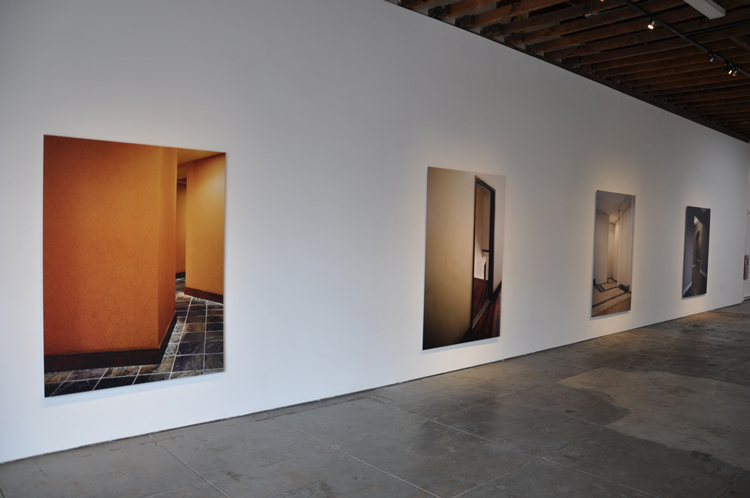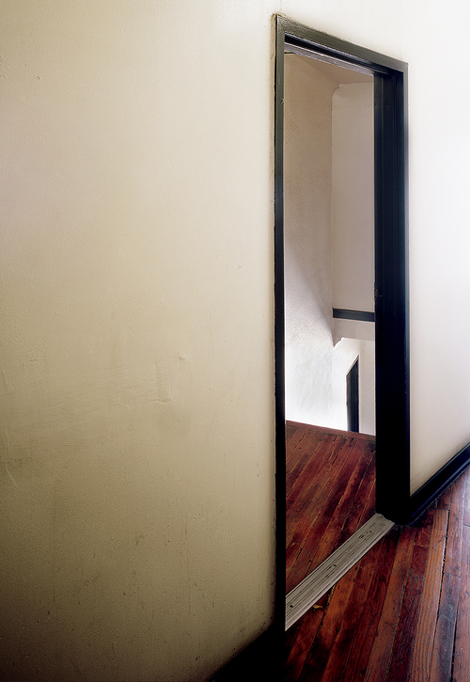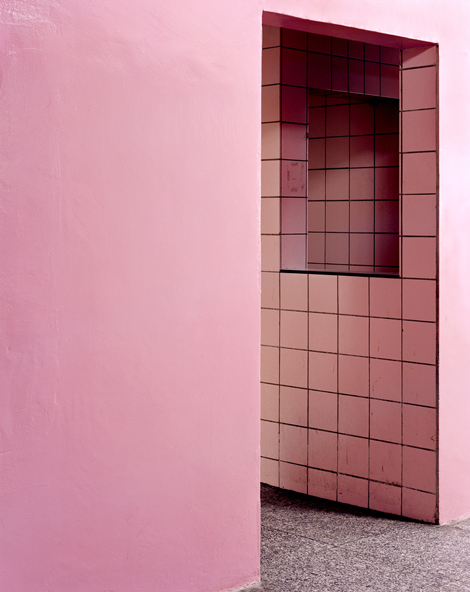It seems every traveler, on occasion, suffers a collapse of time and space. Careening down a hotel hallway late at night, carrying a suitcase whose weight amplifies the exhaustion from hours of cramped travel, one’s head begins to spin. Doors, walls, and expanses of carpet all start to look the same. Details collapse; perception short-circuits. One forgets which day it is, the room number, what hotel and city this is—is it thousands, or just hundreds of miles away? But it all seems so similar to yesterday.
The banality of institutional spaces has a way of triggering momentary lapses in situational awareness. Losing track of time and location elicits a yearning for a pleasant view from a window, fresh air, anything to re-establish one’s bearing.
“Not an Exit,” Austin Irving’s show at Wilding Cran which ends this weekend, channels travel-induced confusion into 10 large-scale photographs of mysteriously unsettling interiors from around the globe.
Evoked collectively through Irving’s installation, this confusion is paralleled by perplexing spatiality within each depicted interior. Spring Street, Los Angeles, CA (2013) exudes a sterile elegance, vapid and labyrinthine like a house of mirrors. In Edgemont Estates, Los Angeles, CA (2013), a hardwood floor ends abruptly into what appears to be a dangerous precipice. It’s impossible to tell whether the vagary is a trick of photographic perspective or a precarious architectural quirk à la the Winchester Mystery House.
Shot on 4×5 film, each interior is large enough to encompass a field of vision; at close range, corners and walls oppressively close in. From afar, the effect is more cerebral; the bewildering architecture emerges in entirety. Irving’s interiors invoke disquieting feelings of being trapped, not only physically, but also mentally, inasmuch as they posit inscrutable architectural conundrums. They are impenetrable.
The photographs’ content, however, is open-ended. In his 1992 essay “Non-Places: Introduction to an Anthropology of Supermodernity,” French anthropologist Marc Augé defined his term “non-places” as spaces which “cannot be defined as relational, or historical, or concerned with identity”—generic locations like hotels, supermarkets, or train stations that are designed for certain transient purposes and are therefore not significant as meaningful “places.”
Dry-mounted to Dibond (an aluminum composite) and coated with matte laminate, each print protrudes from the gallery wall by way of unseen wooden braces. The pieces themselves become temporary extensions of the gallery walls; their materiality and side-by-side installation call attention to the gallery as a non-place like those depicted. Shows are assembled and disassembled; viewers come and go.
The title and content of Irving’s show are reminiscent of Sartre’s 1944 play No Exit, in which three strangers, having died, find themselves in a room together. It’s hell. A character begs the unknown authority presiding over the room to let him out. Suddenly, the door, having been locked, flies open. Then, he decides \he doesn’t want to leave, after all. Though unpleasant, the familiar room is comfortable enough not to risk venturing into the unknown, which might be worse.
Like the portal in No Exit, the door in Eagle Rock, Los Angeles, CA (2015), seems as imposing as the dead-end corner from which it tenders potential escape. Irving’s show eloquently encompasses the psychological tension between longings for novelty and aversions to change that these oppressive yet familiar interiors elicit.
Austin Irving: NOT AN EXIT
MAY 19 – JUNE 27
Wilding Cran Gallery
939 S. Santa Fe Avenue,
Los Angeles, CA 90021






